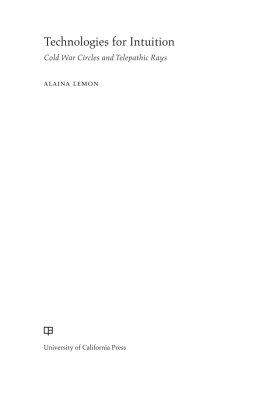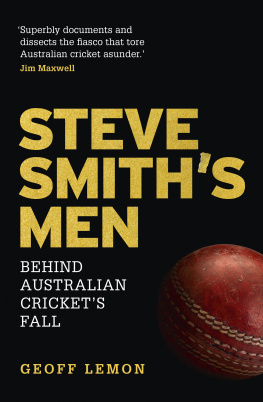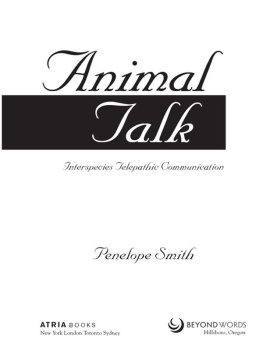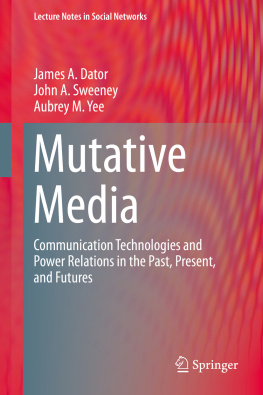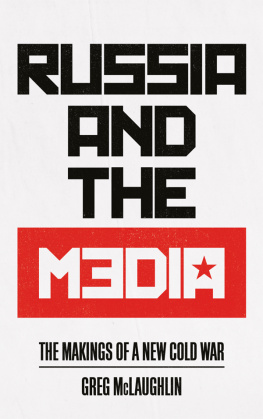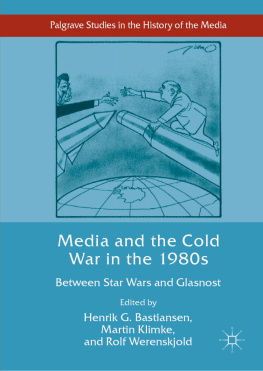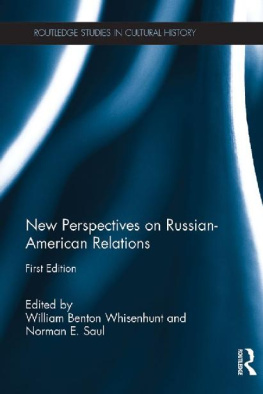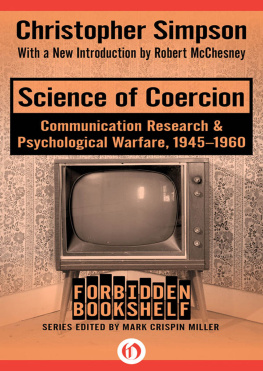Technologies for Intuition
The publisher and the University of California Press Foundation gratefully acknowledge the generous support of the Barbara S. Isgur Endowment Fund in Public Affairs.
Technologies for Intuition
Cold War Circles and Telepathic Rays
ALAINA LEMON

University of California Press
University of California Press, one of the most distinguished university presses in the United States, enriches lives around the world by advancing scholarship in the humanities, social sciences, and natural sciences. Its activities are supported by the UC Press Foundation and by philanthropic contributions from individuals and institutions. For more information, visit www.ucpress.edu.
University of California Press
Oakland, California
2018 by Alaina Lemon
Library of Congress Cataloging-in-Publication Data
Names: Lemon, Alaina, 1965- author.
Title: Technologies for intuition : Cold War circles and telegraphic rays / Alaina Lemon.
Description: Oakland, California : University of California Press, [2018] | Includes bibliographical references and index.
Identifiers: LCCN 2017026641 (print) | LCCN 2017030515 (ebook) | ISBN 9780520967458 (ebook) | ISBN 9780520294271 (cloth : alk. paper) | ISBN 9780520294288 (pbk. : alk. paper)
Subjects: LCSH : Telepathy. | ParanoiaPolitical aspects. | Cold WarInfluence.
Classification: LCC BF 1171 (ebook) | LCC BF 1171 .l38 2018 (print) | DDC 33.8dc23
LC record available at https://lccn.loc.gov/2017026641
Manufactured in the United States of America
27 26 25 24 23 22 21 20 19 18
10 9 8 7 6 5 4 3 2 1
Contents
Illustrations
P.1. |
1.1. |
2.1. |
2.2 and 2.3. |
2.4. |
3.1 and 3.2. |
3.3. |
4.1. |
4.2. |
7.1. |
7.2. |
7.3. |
8.1. |
8.2. |
A.1. |
A.2. |
Prologue: Cold War, Contact, and Ethnography
CIRCLES AND RAYS
In August 1991 I stood in the vestibule of one of the most remote stations of the Moscow metro listening to people excitedly convey the events of the day. I was returning from the center streets, where the tanks had rolled in that morning. The conservative contingent had staged a coup, and their first act had been to limit communications, cut off contacts: I had managed to send a telegram home from the Central Telegraph building near Red Square before it shuttered its doors. Television was jammed, but they had missed another important channel: the metro. Public transit infrastructure was itself an active circuit for other media, from flyers to good old face-to-face talk with strangers (Lemon 2000b). Phone calls were barely getting through, but the Moscow metro, built in a circle cut by radials, was running underneath the capitals rings of roads. Meanwhile, Americans were taking the credit for keeping up flows of communication for the resistance, who soon prevailed, as Western nongovernmental organizations (NGOs) sent faxes on their upgraded lines, embassy satellite dishes amplifying waves abroad. No one paid much attention to the ways a socialist-built infrastructure like the metro carryied messages along with peopleand people as messages, their very numbers swelling to tell a story.
Fast forward. One hundred years after the Russian Revolution and more than fifty since the McCarthy era, we see more clearly that Americans, too, work to cut off what they label excess communication when we worry about foreign influence and contact. Yet we continue to pay little attention to the material and mundane ways in which people are already distanced, even severed from channels along which they might get in touch. Moreover, instead of following particular transnational circuits (the money, the oil, the real estate) to see which circuits are clear and which are blocked, to whom, and to acknowledge the specific channels that we have dug, we continue to behave as if the main thing to worry about is the diffuse hypnotic power of foreign memes over the minds of the masses or about whether politicians are vulnerable to attack by vague manipulations or even telepathic rays.
This book is an attempt to theorize channels and contacts in social, political, historical, and semiotic terms. It is also an attempt to deflate anxiety about mental influence, be the threat imagined to emanate from televisions or psychic spies. The material and social forces for and against communications, across state borders and within them, can be difficult to see, and less visible to some than to others. So let us begin with what can be easily seen, with spectacle, even with fantasy, with one of the late Soviet eras best-known science fiction films, Solaris (dir. Tarkovsky, 1972).
The film depicts telepathic emanations less as rays and more like expanding circles of swirling biomatter and energy. The planet Solaris exudes a mental force, a noospheric sheath of consciousness (see Vernadsky 1926). Solaris reads the minds of the cosmonauts in her orbit, to materialize their most troubled memories, the people they have lost. The readings are limited: corporeal copies live and breathebut manifest their mourners guilt, missing the originals perspectives; one cosmonauts wife lacks a back zipper on her dress because he had never noticed it. The cosmonauts think the planet tortures them while they fail to intuit much about either the planet or each other. The American remake of Solaris settles deeply into a Freudian meditation on hidden psyches; the Soviet version unsettles the human psyche as a player in galactic communications. The Soviet ending frames an evocative detail: one cosmonaut has brought a small houseplant from Earth; just when the humans abandon the exploration, a long shot shows the plant facing out to Solaris from a window in the space station. In the next scenes Solaris morphs, becoming earthlike; gaseous masses congeal into green forest and blue ocean. Some viewers interpret these last scenes as occurring within the protagonists broken mind; others see real planetary changes imperfectly catalyzed by human memories of home. But what if it is the plant who finally establishes a channel with a planetary mind?
Cold War fictions of all genres famously worry about influence over the very conditions for and forms of contact. Much science fiction of the era ends more happily than Solaris: someone cracks a code, the army finally telephones a linguistic anthropologist just in time to prevent nuclear catastrophe over a misunderstanding. The aliens mean no harm. Such tales warn of the limitations of individual intuitions, like nervous reflexes that lead us to misread attempts to make contact, misreadings that threaten to scatter the world with ash.
The little houseplant in Solaris presents a suggestive contrast. Even before science fiction emerged as a late Imperial genre, social circles, fields of friendship, practices of kinship, and institutional circuits chained across state borders. Those who recognize the long centuries of such relations tend shoots that sprout and thrive across borders, but that look like untidy weeds to the paranoid perspective. Xenophobia erases efforts to make contacts that, from a limited, purified perspective, seem inconsequential, ignoring most everyday contacts while magnifying the winks and handshakes of the powerful, mistaking circles for rays.
Throughout the nineteenth century, paranoia about mental influence oscillated with hopes for spiritual health
Next page
